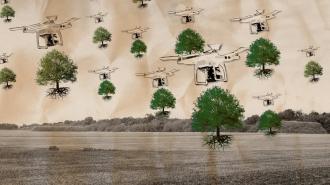Big wildfires are becoming the “new norm.” The National Interagency Fire Center reports that the 10-year average for wildfires has more than doubled since 1990, with more than 10 million acres burned in 2017. In 2018, California alone had a record-breaking fire season, with nearly 2 million acres burned.
We get the point already — wildfires are getting worse.
Now, the Seattle startup DroneSeed is reforesting the charred landscape by releasing a swarm of tree-planting drones, which will reforest the mountainside — fast.
Forest fires can occur naturally, cleaning away excess undergrowth and making way for new trees to take root. But circumstances like climate change and forest monocultures are exacerbating the problem. And while “acres burned” makes headlines, “acres replanted” struggles to keep up.
The arduous process of reforestation involves up to three years to get seedlings from a nursery since the little guys need time to grow. And, while wildfires wipe out millions of acres each year, the total acreage and types of trees vary wildly, so nurseries may struggle to estimate the demand, let alone keep up with it. Once the seedlings are ready, a ground crew is tasked with performing back-breaking work.
“You have to hire superheroes to go out there and plant these things with shovels,” Grant Canary, co-founder of DroneSeed says, explaining that the crew has to hike up and down mountainsides many times a day, often exerting the energy of an ultramarathoner.
DroneSeed has a solution: replant them from the air using tree-planting drones and a seed puck containing “the secret sauce.”
Canary won’t divulge what is in the secret sauce, but he says it allows them to skip the nursery phase and move right into distributing seeds onto the mountain. The puck acts like a seedbed — providing nutrients and anti-fungals so the seedling can thrive. It protects the seed from its most significant threats: rodents, fungus, and drying out.
The seed delivery vehicles are pimped out tree-planting drones. The custom UAVs are equipped with cameras, magic seed pucks, and a brain. The cameras scout the aftermath of a fire, use AI to map objects and terrain in great detail, including flora types, and then distribute the seed pucks in the perfect locations. The entire process cuts down on manpower, time, and danger (as low-flying helicopters that spray herbicide can be very dangerous).
“If you have a 50,000-acre fire, or a 200,000-acre fire, and don’t have the planting capacity — you have no plan. If a fire burns the next year or the year after that, you still have no supply, and you are 10 years behind, then 20 years, then 30 years behind,” Canary says. DroneSeed is determined to catch up by building efficient and smart reforestation drones.
Canary sees the forest for the trees. He cares about replanting woods, but his overall goal is to build and maintain a defense for climate change. That perfect army: trees.
“Any way you slice it, if you want to pull millions of tons of carbon out of the atmosphere — which is what we need — where are you going to put it? Trees are the cheapest method to sequester carbon. And it is the most sci-fi method out there,” he says.
Canary says we need to make trees faster, but the current methods don’t allow that to happen. The DroneSeed tree-planting drones are six times faster than manual planters.
Canary’s next project is in eastern Washington. Canary estimates that over 100,000 acres burned. The local nursery that supplies the seedlings for reforestation only has a fraction of the trees needed. So DroneSeed is stepping in to help out.
Despite the lofty mission of saving forests (and the climate) with tree-planting drones, Canary is still a kid at heart. He especially loves climbing and smelling cedar trees: a throwback to his childhood that was chock full of tree-climbing and fort-building.
“I would love for other people to be able to have that childhood. So we have got to have trees for them to be able to do that,” he says. “Everybody is hardwired to love trees.”






